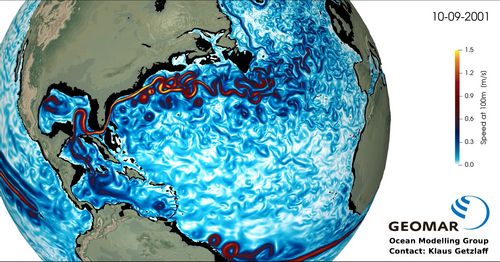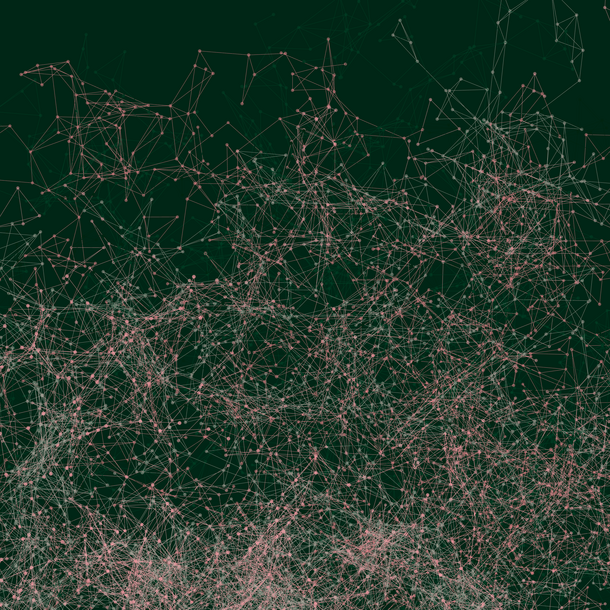Deciphering ocean currents with neural networks and data mining
Doctoral Researcher:
Yannick Wölker, GEOMAR and CAU Kiel, ywoelker@geomar.de
Supervisors:
- Prof. Dr. Arne Biastoch, Ocean Dynamics, GEOMAR Helmholtz Centre for Ocean Research, abiastoch@geomar.de
- Prof. Dr. Matthias Renz, University of Kiel, Department of Computer Science, mr@informatik.uni-kiel.de
Location: Kiel
Disciplines: Computer Science, Machine Learning, Physical Oceanography
Keywords: Explainable-AI, Pattern Mining, Graph Neural Networks
Motivation:
One of the most important circulation systems in the world is the Atlantic Meridional Overturning Circulation (AMOC). In the upper layers of the Atlantic, warm water is transported northward and in the deeper layers cold water is returned. For the global weather and especially for northern Europe this heat transport is very important and under research for a long time in marine sciences [1]. The AMOC itself is not easy to measure, because the speed of the water is small and the transport happens distributed over the complete Atlantic basin. There are some efforts to establish measurement arrays, that are able to track the AMOC, but they are limited in their spatial coverage and in the amount of measured years. From this observational data it is known, that the AMOC has a lot of variability in it from small to large time scales. Because this changes can determine the weather of northern Europe, also the impact of the climate change to AMOC is an ongoing research question. In this PhD project I will investigate if changes in the strength of the AMOC can be backtracked to regions in the ocean that are representative for the largescale AMOC changes. With this correlation between changes at a smaller spatial scale and its impact to the overall heat transport in the Atlantic, it will be possible to backtrack new AMOC signals into already existing observation data. This kind of work is a rising topic in the marine science, to approximate physical processes with a machine learning model and afterwards explaining what the model has learned [2][3].
Aims
Besides relying on observational data also simulations of the ocean can be used to track the AMOC. With the simulation data there is a high spatial resolution that covers most of the Atlantic with a longer available time period. The ocean simulation framework that produces the output is capable of simulating all important physical properties and equations, so that the simulation itself is consistent. In this way the behavior of the AMOC is well captured by the simulation framework and it will be possible to transfer insights from the simulation data to the observational data. Important features in the simulation and the observation can deviate in their position or time, because the simulation is a complete virtual environment, this requires a solution to better transfer the insights. Outgoing from the output of such simulations the AMOC and especially its changes will be investigated with data science methods. To understand the AMOC and its most important drivers, we start our approach from a datadriven perspective so that the dynamics have to be fully encoded in our model. After we created such an model with an sufficient accuracy, the next step will be to understand the model with Explainable-AI methods. This work will lead us to the smaller scale drivers of the AMOC. When we understand the underlying behavior of the model that approximates the AMOC, we will try to find this AMOC driver signals in existing observations. The idea is to find not known relations between local processes in the Atlantic and the strength of the AMOC, that in the end are confirmed by observational data.
Objectives
(1) Find a representation of the simulation output, that captures the important structure of the Atlantic, which could be found either in the simulation but also in the real world ocean and its observations. With such an representation the insights are later not dependent on exact positions or time, also the size of data can be reduced from million of simulated grid boxes to only few important features.
(2) Build a machine learning model that is able to represent mostof the AMOC dynamics.
(3) Use Explainable-AI methods to understand themodel and extract local changes and their impact on the strength of the AMOC.
(4) Searching for the extracted drivers also in non-simulated data sets.
References
- [1] Biastoch, A., Schwarzkopf, F. U., Getzlaff, K., RÅNuhs, S., Martin, T., Scheinert, M., Schulzki, T., Handmann, P., Hummels, R., BÅNoning, C. W. (2021) Regional imprints of changes in the Atlantic Meridional Overturning Circulation in the eddy-rich ocean model VIKING20X. Ocean Science, Vol. 17, No.5
- [2] Sonnewald, M., Lguensat, R. (2021) Revealing the impact of global heating on North Atlantic circulation using transparent machine learning. Journal of Advances in Modelling Earth Systems, Vol.13, No. 8
- [3] Toms, B.A., Barnes E.A., Hurrell J.W. (2021) Assessing Decadal Predictability in an Earth-System Model Using Explainable Neural Networks. Geophysical Research Letters, Vol. 48, No. 12









